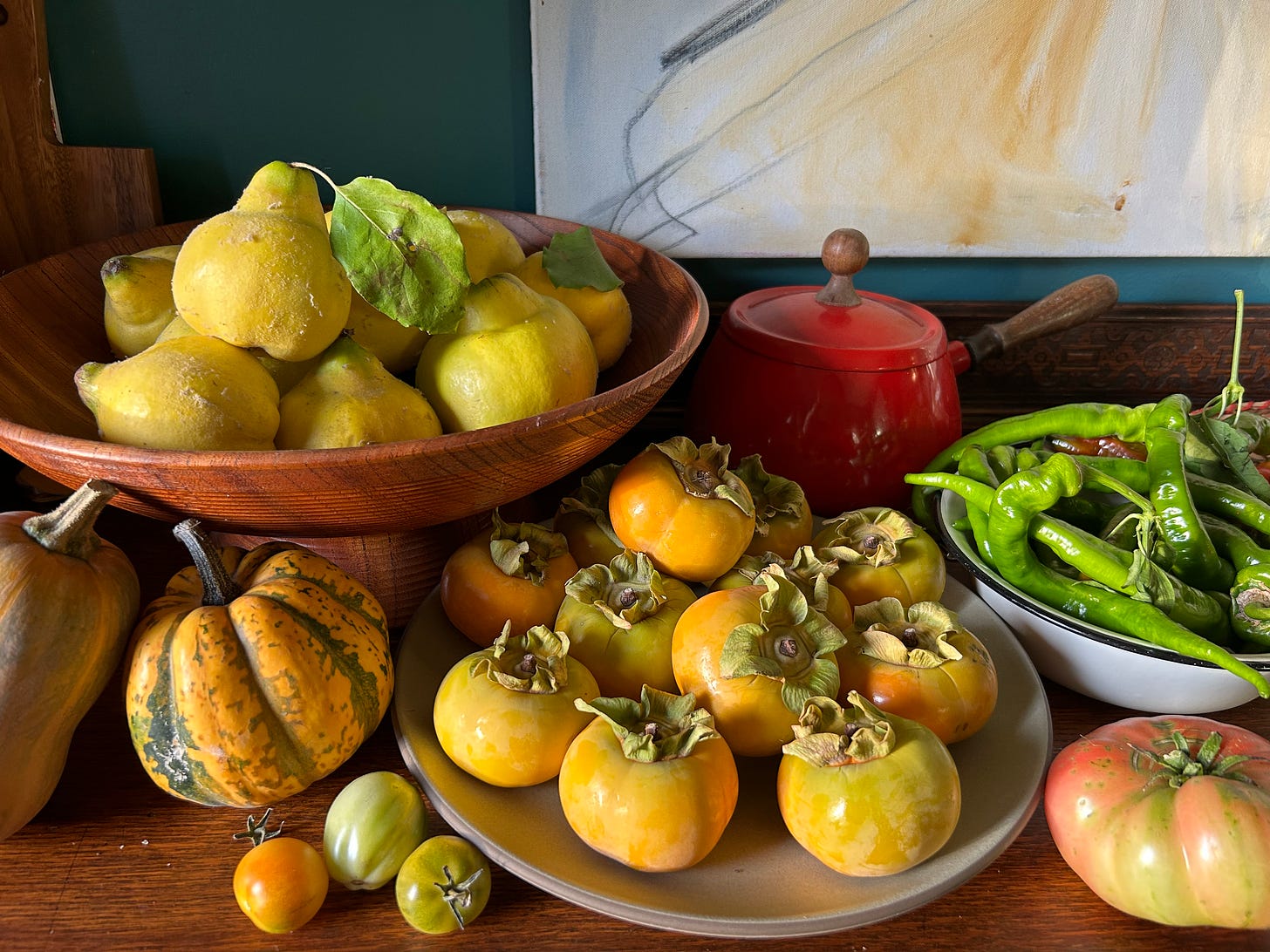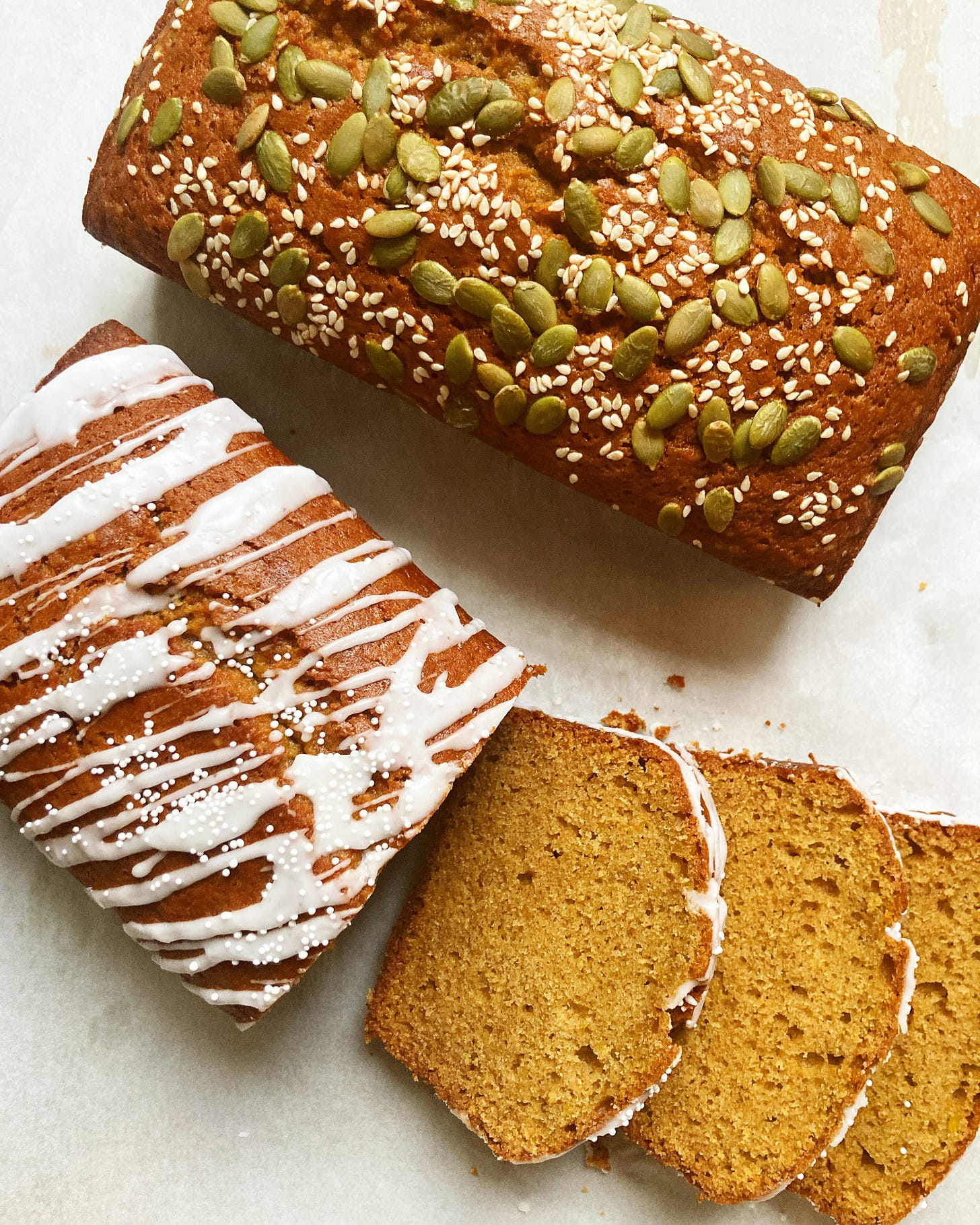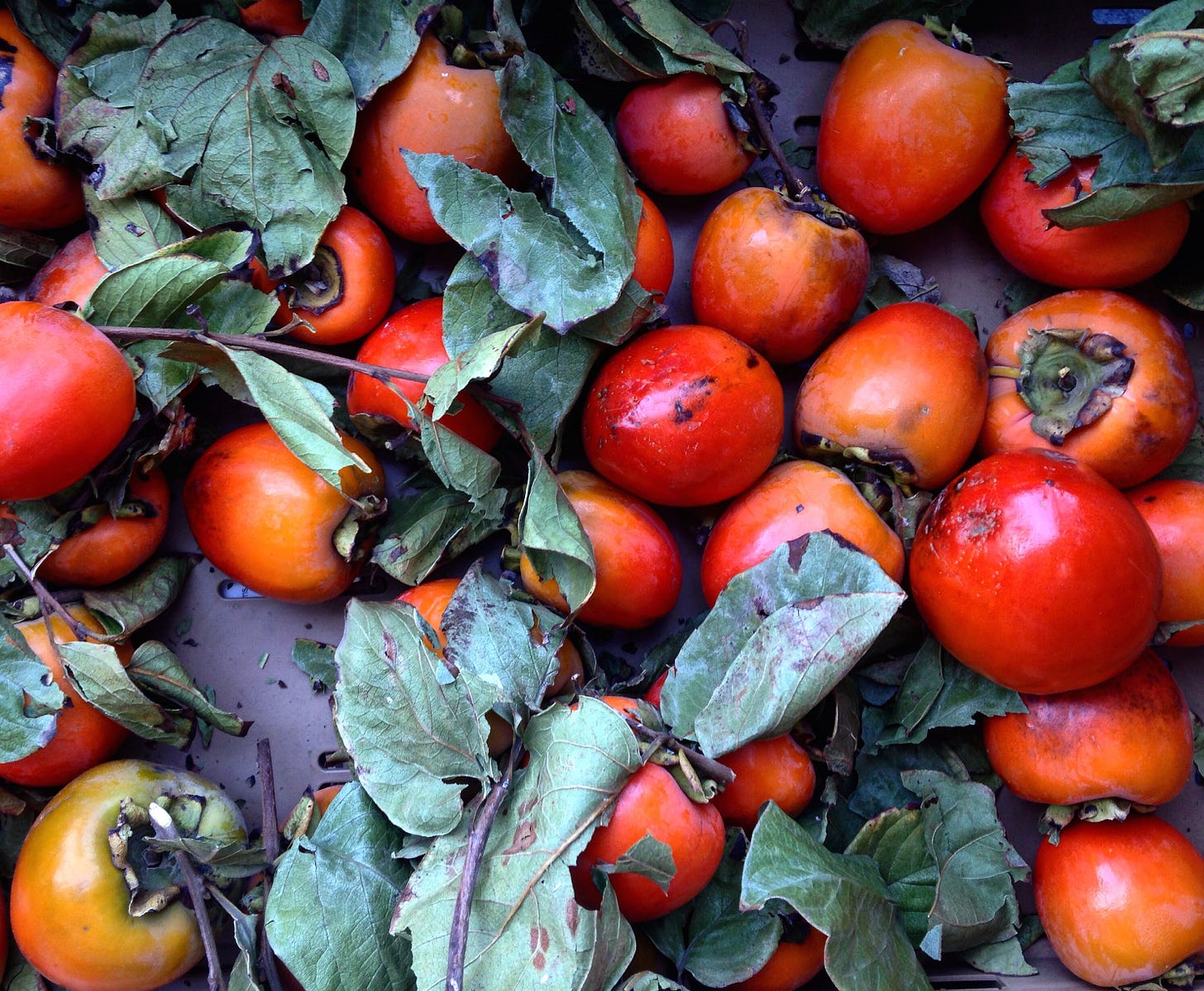Classic pumpkin bread and a pile of fresh quince
What do you do with fall's most fragrant fruit?
In search of an easy, tried-and-true pumpkin bread recipe?
You’ll find it below!
But first….
It’s been two years since Kari and I started Food Friends: Home Cooking Made Easy to help each other and fellow home cooks by sharing trusted, foolproof recipes and tips. Embarking on a new cycle around the sun, we launched a survey to discover what would be of the most value to our community. If you’re a listener, we’d love to hear from you! Everyone who completes the survey will be entered into a giveaway, which includes a copy of my cookbook, a limited edition kitchen towel designed by artist/chef Eden Batki, and a gorgeous tomato candle from the Hollywood Farmers’ Market in LA.
Have you ever smelled a quince?
A few days ago, our close friends came to visit. They live a few hours from the Portland airport, and it was helpful to them to crash here before catching a flight to Europe the next day. They live on a beautiful piece of land in rural Oregon with a small orchard of trees and a verdant garden. As a gift to us, and also to ensure the produce wouldn’t go to waste, they brought an array from their property: an enormous box of quinces and apples, peppers, cabbage, cucumbers, turnips, beets, and a giant head of cauliflower.
Most of the quinces have already been gifted to a pastry chef friend, the cauliflower was roasted that same night for dinner (with onion wedges, cubed sweet potato, and spiced with garam masala), and the apples will soon be turned into the BEST no-sugar-added, leave the peels on, slow-cooker apple butter (also… apple butter makes an elite filling for rugelach, babka, or challah!).
If you find yourself with fresh quinces, do yourself a favor and place a heap in a bowl on the counter, leave the house, and return home to the wafting generosity of this unusual fruit. Golden and fuzzy, it smells of pineapple and warm cider, with a touch of honey and vanilla. I always look forward to October more than any other month, and the smell of quince roots me in the joy of this particular soon-to-be-over moment. After a long walk on a crisp day, entering the house and being greeted with the scent of quince is as much a gift as any confection I’ll cook with it.
So what do you make with quince? High in pectin, quince is often transformed into membrillo - a Spanish jelly-like paste that pairs wonderfully with a sharp cheese. I will likely poach a few and stash them in my freezer; once cooked quince turns an inviting rose color, and that poaching liquid makes for an excellent syrup for cocktails and mocktails. Poached quince can be eaten on its own (dolloped with cream), but it can also be used as a filling for tarts and pies — like this slab pie made with store-bought puff pastry. For a savory preparation, every Thanksgiving I roast my turkey on a bed of quince, onions, and carrots; the fruit adds subtle sweetness and depth to the bird, and the drippings make for the most aromatic gravy. Most years, I thinly slice and dehydrate quince, and use those slivers of fruit for homemade tea blends. Nothing quite replicates the aroma of fresh quince, but preservation keeps the dream of October alive.
If you’re in Portland and want to discover more about this fruit, there’s a quince festival happening this weekend.
Outside our quince-perfumed home, squash is mounting at the farmers’ market, and the persimmons are starting to ripen in the neighborhood trees. The freezer and larder call to be stocked — they ask me to cook up soups that can be delivered to someone at a moment’s notice, and to replenish the tea drawer with a generous array of flavors. There is the urge to bake; so many life moments benefit from a shared conversation over a sweet treat. Or maybe shared silence. Sharing. That’s what pumpkin bread was made for.
Do you have a favorite fall cake recipe?
RECIPE
I’ve been making this pumpkin bread since my twenties when it was my go-to “bring to the office” treat. Tender and soft, spiced, and dairy-free, pumpkin bread keeps for days, and is made all the better with a drizzle of glaze that pleasantly crackles between your teeth when you take that first bite. While I typically reach for a can of Libby’s , I love the versatility of this recipe — you can make it with any pureed squash or pumpkin. Better yet, you can even replace the pumpkin puree with hachiya persimmon pulp, and it yields delicious results. To do so, make sure your persimmon is very ripe, scoop out the center, discard the peels and seeds, and add 2 cups of it to this batter in lieu of pumpkin. Best news: this is a beginner-friendly recipe that requires zero fancy equipment.
Pumpkin Bread
Makes 2 (9”x 5”) loaves
Ingredients:
1¾ cup sugar
½ cup brown sugar
1 cup oil (olive, avocado, sunflower, or whatever you like)
3 large eggs
2 cups (15 oz/ 425 g) pumpkin puree*
3 cups (360 g) all-purpose flour
1 tsp ground cinnamon
½ tsp ground allspice
½ tsp ground nutmeg
¼ tsp ground clove
1 tsp baking soda
½ tsp baking powder
½ tsp fine salt
For the glaze:
1 cup powdered sugar
1-3 Tbsp orange juice or milk, as needed
*Note: To make this with persimmon instead of pumpkin, you will need to use the hachiya (oblong) variety — photo below. Let it ripen until soft/mushy, scoop out the pulp, remove any seeds, and use 2 cups worth for this recipe
Directions:
Preheat the oven to 350°F.
Butter and line two loaf pans with parchment, either 9 x 5-inch or 8.5 x 4.5-inch pans work.
Using a whisk or handheld mixer, beat the white sugar, brown sugar, and oil until well combined.
Mix in eggs, one at a time, until each is fully incorporated.
Mix in the pumpkin puree.
In a separate bowl, sift together the flour, spices, baking soda, baking powder, and salt.
Stir half of the dry mixture into the wet ingredients until just combined, then add the second half of the dry ingredients and stir until combined — be careful not to overmix.
Divide the batter evenly between the 2 pans.
Bake for 1 hour and 10 minutes on the center rack, or until a cake tester (or wooden skewer or paring knife) comes out clean; every oven is a little different so I recommend testing after 60 minutes.
Cool for 10 minutes in the pan.
Remove from the pan and let the loaves continue to cool.
For the glaze: With a whisk, combine the powdered sugar with orange juice or milk. Start with 1 Tablespoon of liquid, and then depending on the desired thickness, add more if needed. You want the glaze to feel thick but still able to easily drip off of a spoon.
Drizzle the cooled loaves with the glaze and let the glaze harden and set for at least 30 minutes. Slice and serve.
Pumpkin bread can be stored for up to 5 days in an airtight container at room temperature, or wrapped and frozen for up to 3 months (if freezing, do not glaze until it’s thawed).







This sounds delicious! I love the image of quinces wafting their generosity.